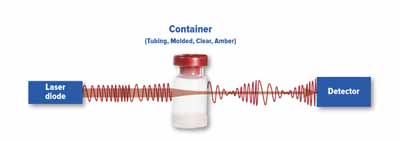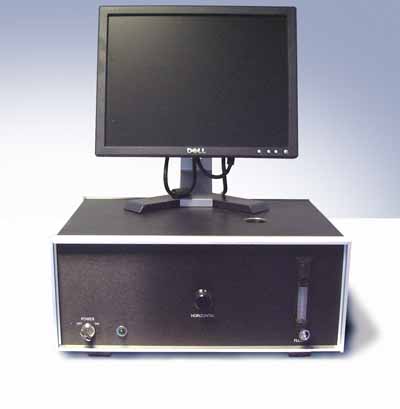Freelance Sarah Webster describes how Biopharma Technology is using laser-based headspace moisture analysis for rapid and non-destructive moisture determination of freeze-dried pharmaceutical products
Moisture analysis is a fundamental aspect of the complete freeze-drying process to ensure the system is efficient and performing as it should. Consequently, moisture analysis is performed in both product and process development, as well as in manufacturing to specify and control the maximum allowable moisture content.
Replacing the slow traditional methods, such as Karl Fischer titration (KF) and thermo-gravimetric analysis (TGA) with a rapid, non-destructive method would streamline moisture analysis efforts and help improve the quality of the finished product.
Capitalising on the development of an instrument that uses frequency modulation spectroscopy (FMS) to perform laser-based headspace inspection as a rapid method to analyse and inspect the moisture in a finished drug product,1 Biopharma Technology (BTL) has carried out extensive testing of the FMS method on freeze-dried materials.
Industry applications of headspace moisture analysis include freeze-drying cycle optimisation, lyo-chamber moisture distribution mapping and complete-batch moisture inspection of commercial freeze-dried products. Headspace moisture analysis has the potential to be a new primary method for lyo-moisture determination that is both rapid and non-destructive.
Freeze-drying is a well-established and standard process in the pharmaceutical industry to stabilise drug products, with associated benefits (increase in shelf life, ease of transport, fewer temperature controls). There are three main stages in the freeze-drying process: freezing, primary drying and secondary drying. If inefficiencies occur at any stage, the moisture content and active viability in the finished product could be compromised.
For example, the moisture map shown in Figure 2 demonstrates the variability of moisture content when a process is changed, showing a set of samples placed on a tray in the freeze-dryer rather than in direct contact with the shelf.
Freeze-drying process variables include:
1. Degree of shelf contact
- Container geometry (tray, vial, stopper)
- Differences in container shelf contact (e.g. due to warping of trays, uneven vial base)
2. Efficiency of heat transfer – conduction and convection, container material
3. Drying rate variations due to product temperature differences, resulting from:
- Shelf temperature variation (ramp, hold)
- Radiative heating effects (various patterns – e.g. related to door, positioning of condenser)
- ‘Flat spots’ in chamber pressure (particularly if insufficient shelf spacing)
- Annealed or non-annealed – ice crystal size, pathways for vapour to escape
4. Process parameters used (shelf temperature and chamber pressure)
5. Cooling and re-warming rates/capacity
6. Condenser trapping rate
Variables also arise from the excipients/active material due to:
7. The nature of the formulation itself
- Format (solution, suspension, pellets, etc)
- Ingredients’ individual and combined behaviour and material type/structure e.g. amorphous or crystalline.
Successful freeze-drying relies on choosing suitable components for the formulation and establishing the critical temperatures for the product. It is important to understand fully the reasons for moisture variation due to processing and material choices. This understanding can assist in validation and in assessing any changes made based on results of moisture analysis.
Moisture analysis following freeze-drying needs to be fast and accurate, particularly for the often expensive, complex and lengthy procedure of pharma manufacture. Residual product moisture content is critical when considering the stability, shelf life and storage temperature of lyophilised pharmaceutical product.
Stability studies have shown that the degradation of the API correlates to the initial water vapour concentration present in the freeze-dried vial. This means that the moisture analysis performed in product and process development, as well as in commercial manufacturing, is vital in specifying and controlling the maximum allowable moisture content to ensure the quality of the finished product.
Water content also affects the Tg of amorphous materials (the Tg is the point at which a material can be observed to undergo structural change), which could further affect stability and long term storage temperature.
Moisture analysis is traditionally performed using KF titration or TGA methods, which are time consuming, involve chemical reagents and, critically, destroy the sample. Furthermore, KF titration and TGA do not distinguish between active water and bound water. Water is present in a lyophilised cake in a variety of forms (including free, adsorbed, chemically bound and water of crystallisation) and not all of these are linked to product stability through degradation of excipients and active ingredients. Generally, free or active water is available for chemical reaction and has the greatest impact on product stability.
Replacing these slow traditional methods with a rapid, non-destructive method could streamline moisture analysis and help improve the quality of finished product.
Under the guidance of Isobel Cook, principal research scientist at BTL, a headspace moisture analysis method has been investigated. As a rapid and non-destructive method, it could be an ideal tool to characterise lyophilisation cycle efficiency and freeze-dryer performance across shelves, between shelves and as a function of drying cycle parameters. The method may also be suitable for performing moisture inspection of 100% of the finished product and even monitoring moisture content of individual vials over the entire shelf life.
The headspace moisture analysis method being investigated by BTL uses FMS. This involves passing a laser light through the vial headspace; the laser is tuned to the absorption wavelength of the water molecule and the absorption signal analysed to determine the headspace vapour pressure. The vial headspace vapour pressure can allow determination of the moisture content of a lyophilised cake by performing a correlation between FMS and KF using a set of samples with moisture ranging from below the target moisture level to 150% above the specification.2 Experiments have also demonstrated that the amount of headspace water vapour can be directly correlated to levels of drug product stability.2

Fig. 3: Diagram of FMS shows path of laser through vial
As mentioned above, one of the most important benefits of headspace moisture analysis is the ability to test entire batches. This can provide insight into the efficiency of the drying process and the dynamics of freeze-drying in different locations within the freeze-dryer. In addition, quality control groups would benefit from being able to non-destructively sample a statistically significant number of finished product vials as part of a release test as well as monitoring individual vials repeatedly over the product shelf life.
Finally, 100% moisture inspection of finished vials would guarantee the quality of finished product with respect to stability against moisture.
FMS is a high sensitivity laser absorption technique. The laser is tuned to match the internal water absorption frequency at 1,400nm; the amount of laser light absorbed is proportional to the water vapour concentration. Analysis time is around 5 seconds per vial, is non-destructive (the same vial can be monitored over time) and enables complete batch inspection.
Diode laser-based systems can be configured in a variety of ways to monitor and control processes and/or inspect individual containers for headspace oxygen, moisture or vacuum. The two basic configurations include bench-top systems for use off- or at-line and fully automated systems for 100% monitoring, control and inspection.

Fig. 4: The instrument used – the FMS-1400 from Lighthouse Instruments
In summary, headspace moisture analysis based on FMS can be used as a method to further our understanding of the factors involved in obtaining uniform moisture content and to control the quality of finished product.
Data has shown that even for an apparently well-developed lyophilisation cycle a number of random vials may occur with out-of-specification moisture content. The only way to identify those random out-of-specification vials is to perform moisture inspection across the entire batch. Once headspace moisture studies have been more thoroughly investigated and understood, this method could be applied to the non-intrusive and rapid analysis allowing the monitoring of large production batches, ideally on a 100% inspection basis.
FMS can also be used in conjunction with KF analysis to assist in fast and efficient analysis of a large number of samples and to yield important information about the freeze-dried product, namely enabling the elucidation of the location and dynamics of water present in lyophilised cakes. It is also possible to investigate changes within a series of samples and assess how they are related to amorphous/crystalline changes, as well as headspace moisture resulting from vial stoppers and temperature effects.
Any in-depth moisture study surrounding freeze-dried products demonstrates the complexities involved in understanding the ‘nature’ of the water present in lyophilised products and establishes the importance of gaining a thorough understanding of the excipients, the various process conditions, temperature, storage and stopper properties in order to understand and evaluate results for repeatable and accurate FMS analysis.
Further temperature and headspace moisture studies are warranted to increase understanding of the location and dynamics of the water within the system. Once constant parameters have been established and temperature tightly controlled, chemical and physical changes could be more accurately monitored and predicted over time. However, initial results indicate that rapid moisture determination with headspace analysis using FMS could replace the slow and destructive traditional methods for the moisture analysis of freeze-dried products.
References
1. Cook, I., Ward, K. and Duncan, D. (2008) ‘Freeze dried cakes –Where is the water?’, Conference on Freeze Drying of Pharmaceuticals and Biologicals Breckenridge, Colorado, August.
2. Peeters, M., (2006) ‘Results FMS vs KF Analysis’, Lighthouse Instruments European User Symposium June.





